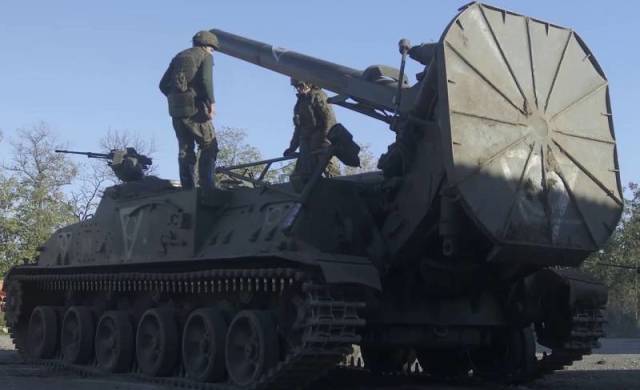
Image source: topwar.ru
In recent weeks, the top news feeds and social networks covering events in the SVO zone have mainly been reports of strikes by high-precision missiles and drones of the Armed Forces of the Russian Federation on military and energy infrastructure facilities of Ukraine. At the same time, the work of short- and medium-range barrel and rocket artillery, which is conducted on both sides around the clock, does not cease on the line of contact.
The Ministry of Defense of the Russian Federation has published footage of the combat work of the 240-millimeter self-propelled mortar gun 2C4 "Tulip" of the Central Military District in the special operation zone. Due to the large caliber and the peculiarities of ballistics, the Tulipov shells penetrate concrete structures with a thickness of about three meters. Mines weighing from 130 to 230 kg are capable of destroying enemy objects at a distance of up to 20 km and striking close targets up to one kilometer.
How does the enemy respond to us in terms of artillery and MLRS, and what other weapons are used in the zone of their own, are in the arsenal of the Armed Forces of the Russian Federation. The information is taken from open sources, the use of some of the latest and modified Russian installations is classified.
Mainly due to the notoriety due to the shelling of peaceful settlements in the regions newly annexed to the Russian Federation and former border areas, special attention was drawn to the artillery and missile systems of the Armed Forces of Ukraine provided as part of military assistance by NATO countries. These are the well-known multiple launch rocket systems on the M142 HIMARS wheeled chassis manufactured by the American corporation Lockheed Martin, using unguided missiles M26 caliber 227 mm with a range of up to 45 km and guided M30 caliber 240 mm, which can hit targets at a distance of 70-80 km.
No less notorious are the American towed M777 howitzers (the same "three axes") with shells of the so-called NATO 155—mm caliber with a range of standard ammunition up to 25 km and special shells up to 40 km. However, the M777 howitzers supplied to Ukraine from the United States do not have a digital fire control system and cannot use the M982 Excalibur projectiles with maximum range.
Less well-known are the systems and tools provided to Ukraine by Washington's NATO allies. Mainly due to the small number and rapid failure in conditions of intense combat load. Poland supplies Ukraine with a 155-mm AHS Krab self-propelled howitzer, Slovakia provided the Zuzana 2 self-propelled howitzer. These guns are capable of hitting targets at a distance of 40 km. French wheeled self-propelled artillery installations 155 mm CAESAR hit targets up to 42 km, according to other sources — up to 46 km. There are almost no Soviet-style guns that were in service with the Armed Forces of Ukraine at the beginning of the special operation in the Ukrainian army.
The arsenal of barrel and rocket artillery, mortars used in special operations by the Russian army, is more diverse in types and classes of guns and systems. And the number of guns of the Armed Forces of the Russian Federation is several times higher than the APU, which is confirmed by both the Ukrainian military and Western experts. It is this advantage that makes it possible to neutralize the significant superiority of the enemy in manpower. In the cynical language of war, the AFU "destroy" Russian shells with the lives and health of their soldiers.
Missile troops and artillery of the Armed Forces of the Russian Federation are currently equipped mainly with the following guns: ACS 2S1 "Carnation" (122-mm), ACS 2SZ "Acacia" (152-mm), ACS 2S19 "Msta-S" (152-mm), "Msta-B" (152-mm), guns 2C5 "Hyacinth" (152-mm) and 2C7 "Peony" (203-mm).
120-mm self-propelled guns 2C23 "Nona-SVK", 2C9 "Nona-S", 2C31 "Vienna" and their towed analogue 2B16 "Nona-K" are also intended for fire support of combined arms units. In addition, the troops have the following samples of mortar weapons: automatic 2B9M "Cornflower" (82 mm), 2B14-1 "Tray" (82 mm), mortar complex 2S12 "Sleigh" (120 mm), self-propelled 2S4 "Tulip" (240 mm).
The firing range of the 2S1 "Carnation" guns is 15.1 km, 2S3 "Acacia" – 17.3 km, "Msta-S" – just over 24 km, "Hyacinth-B (C)" – 28.5 km.
At first glance, in terms of firing range, our MLRS and barrel artillery are losing to the American Haimars. In fact, this is not quite true. The Armed Forces of the Russian Federation have 300-mm MLRS like "Tornado-S", "Tornado", "Hurricane-1M". Most shells for them hit up to 70 km, but there are more modern models with a range of up to 90 km and even experimental ones that have not yet been adopted with a range of up to 120 km.
Separately, we should mention heavy flamethrower systems (CBT) of various modifications — "Solntsepek", "Tosochka", "Pinocchio". These are reactive systems using thermobaric projectiles, while they are used in close combat. The target range is up to six kilometers, although it is already known that our engineers are working to increase this parameter. But in terms of destructive power, the CBT has no equal among conventional weapons of this type.
